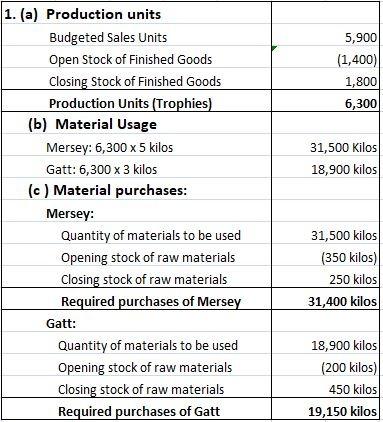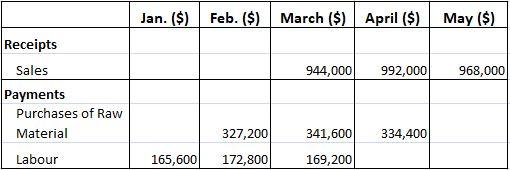Manufacturing companies use production budgets to specify the number of product units to be manufactured. The production budget is determined based on sales forecasts. It is adjusted based on the company's inventory policy in terms of planned inventory levels. Based on the production budget, a manufacturer develops cost budgets for direct materials, direct labor, and overhead costs required for production. When preparing a production budget, an important consideration to bear in mind is the firm's inventory policy. The sales budget is the foundation for the production budget, with adjustments for the starting and ending inventory. Production budgets, similar to sales budgets, are developed on a unit basis. A production budget depends on 3 factors: The production budget also depends on a company's inventory policy. Inventories may be built up or liquidated depending upon the company's strategic outlook. Also, when the firm cannot deliver, the cost of carrying larger inventories should be compared with the cost of having out-of-stock items. The budgets that provide sources for much of the data in the cash budget are: Both the labor utilization budget (also known as the labor budget) and the materials purchases budget rely on the production budget. Therefore, let's first describe how that is carried out. Forecasts of sales units (i.e., units that will be sold) need to be developed first because this is fundamental to the preparation of a production budget. The level of actual production that is required depends primarily on the required movement in finished goods stocks. In real life, the potential rejection of production units is an issue that should be considered when creating a production budget. In this article, however, we will not deal with that complexity, and we will also not factor in the possibility of raw materials wastage. We will, therefore, need to plan to produce the units that we intend to sell, but we can budget to change stock levels. This happens mainly in terms of: The production budget estimates the number of units to be produced in a period using the following formula: Production budget = Budgeted sales units - Opening stock of finished goods + Closing stock of finished goods This can be justified for the following reasons: In summary: A production budget for XYZ Company is shown below. After the production budget has been developed in units, we can calculate the quantity of materials needed and the amount of labor time required. The materials usage budget is created to calculate the amount of raw materials that will be used in production. The labor utilization budget is usually based on labor time in hours, but it can be converted into an equivalent number of full-time employees. Any shortfall in the availability of personnel will become clear at this stage, as will any anticipated requirement for overtime work. The payment of labor as calculated in the labor utilization budget will feed directly into the cash budget. The materials purchases budget can be created after establishing the materials usage budget. Here, differences between the quantity of material to be consumed in production and the quantity to be purchased will depend primarily on the required movement in raw material goods stocks. The reasoning follows a similar pattern to the one described for sales, finished goods, and production. If we already have raw materials in the opening stock, this amount does not have to be purchased, but the quantity that we plan to have in stock at the end of the period must be purchased in addition to the amount that will be used in production. The quantity of material purchased, as recorded in the materials purchases budget, will therefore equal: Quantity of materials purchased = Quantity of material to be used (per materials usage budget) - Opening stock of raw materials + Closing stock of raw materials The link between purchases and raw materials stocks can be summarized as follows: One vital reason for creating a materials purchases budget is that the information on the timing of purchases will feed into the cash budget. This is based on the time at which payments to suppliers need to be made. The case study presented here shows the process used to prepare a production budget. The production budget can serve as the basis for the materials usage and purchases budgets. The purchases budget will then provide the source of data for the cash budget. In this case study, the focal point is a company called Anfield Limited. The task is to prepare production and materials budgets for the company. A manufacturing company, Anfield Limited, makes a single product, the Trophy. The sales forecast for February is 5,900 units. Each unit of Trophy uses 5 kilos of Mersey and 3 kilos of Gatt. The anticipated stocks at the beginning of February are: The required stock levels at the end of February are: 1. Produce the following budget figures for the month of February: 2. Explain how the data produced in the above budgets will be used in the cash budget. 1. 2. The completed purchases budgets for Mersey and Gatt will be used to help prepare the cash budget. This will be done by valuing the quantities to be purchased, and lagging the results by the credit period obtained from the supplier. The above case study was based on one period, the month of February; however, the process is identical if we wish to generate a series of budgets for consecutive periods. Remember that the closing stock values for one period are the same as the opening stocks for the next period, and so on. It is also a straightforward matter to include values and quantities in the budgets if standard costs (or alternative estimates of value) are available. It is then quite logical to see how the data fit into a cash budget. We will demonstrate how this works in the next case study. It involves preparing cash budget data for Highbury Limited. Highbury's sales forecast for the first quarter of the next financial year is as follows: The forecast stock levels on 1 January are: Highbury Limited plans to reduce its raw material stock by 500 kgs. in each month of the first quarter. It will also increase the number of finished Highburys in stock by 2,000 each month in anticipation of a sales drive in the second quarter. The following data are relevant to the cash budget: Task 1 Produce the following budgets for the months of January, February, and March: Task 2 Using the information generated in Task 1, show extracts from the cash budget for January to May relating to sales receipts, payment for purchases, and payment for labor costs. (a) Production of Highbury The calculation could also have been performed by adding each month's increase in finished goods stock to the sales forecast. (b) Usage of Raw Materials (c) Materials Purchases (d) Labor Utilization Task 2 The following is an excerpt from a cash budget: A full cash budget would also include:Production Budget: Definition
Explanation of Production Budget
Preparing a Production Budget
Example: How to Prepare a Production Budget
XYZ Company
Production budget for the year ended 30 June 2024
Total
Q1
Q2
Q3
Q4
Desired ending inventory
60,000
10,000
18,000
25,000
7,000
Cost of goods
30,000
7,000
6,000
9,000
8,000
90,000
17,000
24,000
34,000
15,000
Total opening inventory required
25,000
6,000
5,000
6,000
8,000
Purchases
65,000
11,000
19,000
28,000
7,000
Budgets for Materials Usage and Labor
Example: Case Study 1
Situation


Required
Solutions

Example: Case Study 2
Situation
Highbury Limited produces a single product, the Highbury. Each Highbury has cost data as follows:
Required
Solution
Task 1





Production Budget FAQs
Manufacturing companies use production budgets to specify the number of product units to be manufactured. The production budget is determined based on sales forecasts. It is adjusted based on the company’s inventory policy in terms of planned inventory levels.
Sales forecast in units, as indicated in the sales budget, finished goods inventory level, as set by management in terms of targets for the end of the period and anticipated inventory at the start of the budget period
The production budget is used to create the materials purchases budget by calculating the quantity of material that will be purchased in addition to the amount that will be used in production. The difference between these two quantities will depend on the required movement in raw material goods stocks.
Production budget = budgeted sales units – opening stock of finished goods + closing stock of finished goods
It is important to create a production budget because it allows a company to plan its production in advance and ensures that the correct amount of raw materials will be available when they are needed. This information is essential for creating a accurate cash budget.
True Tamplin is a published author, public speaker, CEO of UpDigital, and founder of Finance Strategists.
True is a Certified Educator in Personal Finance (CEPF®), author of The Handy Financial Ratios Guide, a member of the Society for Advancing Business Editing and Writing, contributes to his financial education site, Finance Strategists, and has spoken to various financial communities such as the CFA Institute, as well as university students like his Alma mater, Biola University, where he received a bachelor of science in business and data analytics.
To learn more about True, visit his personal website or view his author profiles on Amazon, Nasdaq and Forbes.













